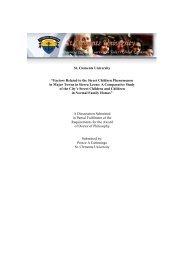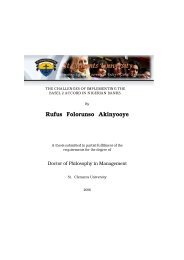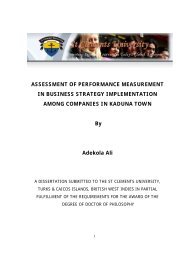The role of informal microfinance institutions in saving
The role of informal microfinance institutions in saving
The role of informal microfinance institutions in saving
You also want an ePaper? Increase the reach of your titles
YUMPU automatically turns print PDFs into web optimized ePapers that Google loves.
3.1.8: Data Process<strong>in</strong>g<br />
<strong>The</strong> data result<strong>in</strong>g from the study could be both quantitative and qualitative and as such, need<br />
process<strong>in</strong>g and analysis. <strong>The</strong> essence is to put the data <strong>in</strong> contextual form to enable the<br />
researcher answer the research questions as well as address the research objectives.<br />
Consequently, quantitative analysis us<strong>in</strong>g simple tables, bar charts, percentage distributions and<br />
statistical analysis were carried out <strong>in</strong> order to establish the relationships between various<br />
variables. Abdullah (2004) noted the need to ensure that the follow<strong>in</strong>g steps were taken:<br />
• That the tables and diagrams have brief and clear descriptive title.<br />
• That the units <strong>of</strong> measurement are clearly stated.<br />
• That the sources <strong>of</strong> data used are clearly stated.<br />
• That notes to expla<strong>in</strong> abbreviations and legends are clearly stated.<br />
• <strong>The</strong> size <strong>of</strong> the sample on which the values <strong>in</strong> the table are based is stated.<br />
• That table had clear column and row lead<strong>in</strong>gs.<br />
<strong>The</strong> analysis carried out enabled the researcher establish the relationships between variables<br />
and trends <strong>in</strong> patterns <strong>of</strong> associations.<br />
3.1.9: F<strong>in</strong>al Model Used <strong>in</strong> Regression<br />
<strong>The</strong> study uses the follow<strong>in</strong>g model to capture the impact <strong>of</strong> SACCOs on <strong>in</strong>come <strong>of</strong> the<br />
poorest 20 percent households <strong>in</strong> Tanzania... <strong>The</strong> model is derived and as a s<strong>in</strong>gle equation<br />
l<strong>in</strong>ear model expressed <strong>in</strong> log l<strong>in</strong>ear form, as specified below:<br />
Grate 20% In poor= C+ (1-G) RGDP rate + GSS rate + SL rate + DMF+ e<br />
C = Constant term<br />
G rate 20% <strong>in</strong> poor = Growth rate <strong>of</strong> nom<strong>in</strong>al private <strong>in</strong>come received by poorest 20%<br />
households <strong>in</strong> Tanzania.<br />
RGDP rate= Real Growth Domestic Product Rate.<br />
GSS rateI= Growth rate <strong>of</strong> Government Investment <strong>in</strong> Social services.<br />
163
















